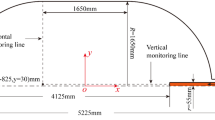Abstract
Liquid oxygen and liquid hydrogen are used as oxidizer and fuel, respectively, in cryogenic stage of a typical heavy lift launch vehicle. In order to ensure optimum propellant loading and suppress cavitation in the pump, the propellants have to be stored at subcooled condition and this is achieved by increasing the ullage pressure above the saturation pressure. Also, due to low temperature of cryogenic propellants, significant amount of heat penetrates into the system. These factors contribute to the development of thermal stratification, wherein low-density liquid propellant, driven by buoyancy effects, gets accumulated at the vapor–liquid interface. The thickness of this stratum of liquid increases with time and plays a vital role in mass budgeting of propellants. Multi-species bubbling is one of the destratification techniques used in flight missions. Quantification of stratified mass in cryogenic stage and the estimation of time for destratification at different flow rate of bubbling gas are essential for the optimum loading of bubbling gas. In the present work, experimental studies were conducted with water-GN2 and liquid nitrogen (LN2)-GHe combination to investigate the development and destruction of thermal stratification of liquid in a sub-scale cylindrical tank of 90 L capacity. Tests with water at 305 K were conducted in open tank and heated using an external source. Tests with LN2 at 77 K, 2.8 bar was carried out using enclosed tank. Development of stratified mass was quantified in both cases based on stratified temperature limit, 311 K and 83 K, for water and LN2, respectively, using closely spaced T type thermocouples. Subsequently, destratification was carried out using gaseous nitrogen (GN2) and gaseous helium (GHe) for water and LN2, respectively. Experiments were conducted for bubbling flow rates in the range of 0.1–0.4 g s−1. The time required for destratification was found to decrease significantly with increase in bubbling rate. 66.6% difference in destratification time is observed between bubbling gas flow rate of 0.1 and 0.4 g s−1. The results obtained in the study can be used in the design and payload estimation of actual propellant tanks.
















Similar content being viewed by others
Abbreviations
- GN2:
-
Gaseous nitrogen
- GHe:
-
Gaseous helium
- LN2:
-
Liquid nitrogen
- DM:
-
De-mineralized
- LOX:
-
Liquid oxygen
- LH2:
-
Liquid hydrogen
- LV:
-
Liquid–Vapor
- PRV:
-
Pressure Relief Valve
References
Schmidt AF, Purcell JR, Wilson WA, Smith RV. An experimental study concerning the pressurization and stratification of liquid hydrogen. Springer, US: Advances in Cryogenic Engineering; 1960. p. 487–97.
Hardy TL, Tomsik TM, Prediction of the ullage gas thermal stratification in a NASP vehicle propellant tank experimental simulation using Flow-3D, NASA Document (1990)
Van DN, Lin C, Hasan M, Self-pressurization of a flight weight liquid hydrogen tank-effects of fill level at low wall heat flux. In 30th Aerospace Sciences Meeting and Exhibit, 1992; 818
Gursu S, Sherif SA, Veziroglu TN, Sheffield JW. Analysis and optimization of thermal stratification and self-pressurization effects in liquid hydrogen storage systems—part1: model development. J Energy Resour Technol. 1993;115:221–7.
Das SP, Chakraboraty S, Dutta P. Studies on thermal stratification phenomenon in LH2 storage vessel. Heat Transfer Eng. 2004;25(4):54–66.
Cho N, Kwon O, Kim Y, Jeong S. Investigation of helium injection cooling to liquid oxygen propellant chamber. Cryogenics. 2006;46(2–3):132–42.
Namkyung C, Ohsung K, Youngmog K, Sangkwon J. Investigation of helium injection cooling to liquid oxygen propellant chamber. Cryogenics. 2006;46:132–42.
Namkyung C, Ohsung K, Youngmog K, Sangkwon J. Investigation of helium injection cooling to liquid oxygen under pressurized condition. Cryogenics. 2006;46:778–93.
Bershadskiy VA, Jung YS, Lim SH, Cho GS, Cho KJ, Kang SI, Oh SH. Determination of the cryogenic propellant parameters at pressurization of the propulsion system tank by bubbling. J Korean Soc Propuls Eng. 2006;10(4):1–10.
Fan J, Furbo S. Thermal stratification in a hot water tank established by heat loss from the tank. ISES Solar World Congr. 2009;2009:341–50.
Ludwig C, Dreyer M, Analyses of cryogenic propellant tank pressurization based upon ground experiments. In AIAA SPACE 2012 Conference & Exposition, 2012; 5199
Lei W, Yanzhong L, Cui L, Zhixiang Z. CFD investigation of thermal and pressurization performance in LH2 tank during discharge. Cryogenics. 2013;57:63–73.
Ramesh T, Thyagarajan K. Performance studies on sub-cooling of cryogenic liquids used for rocket propulsion using helium bubbling. Int J Eng Technol. 2014;6(1):58–65.
Pavitra S, Pritam S, A Simulation studies on cooling of cryogenic propellant gas bubbling. 25th international cryogenic engineering conference and the international cryogenic materials conference in 2014, ICMC 25-ICMC 2014;67: 386–391
Jeswin J, Gagan A, Deepak KA, Pisharady JC, Sunil KS. Effect of insulation thickness on pressure evolution and thermal stratification in a cryogenic tank. Appl Therm Eng. 2016. https://doi.org/10.1016/j.applthermaleng.2016.07.015.
Pritam S, Pavitra S. A dynamic lumped parameter model of injection cooling system for liquid subcooling. Int J Therm Sci. 2018;132:552–7.
Ludwig C, Dreyer ME, Hopfinger EJ. Pressure variations in a cryogenic liquid storage tank subjected to periodic excitations. Int J Heat Mass Transf. 2013;66:223–34. https://doi.org/10.1016/j.ijheatmasstransfer.2013.06.072.
Acknowledgements
This experiment is conducted in PRS laboratory at LPSC/ISRO, Trivandrum.
Author information
Authors and Affiliations
Corresponding authors
Additional information
Publisher's Note
Springer Nature remains neutral with regard to jurisdictional claims in published maps and institutional affiliations.
Rights and permissions
Springer Nature or its licensor (e.g. a society or other partner) holds exclusive rights to this article under a publishing agreement with the author(s) or other rightsholder(s); author self-archiving of the accepted manuscript version of this article is solely governed by the terms of such publishing agreement and applicable law.
About this article
Cite this article
Puthettu Muraleedharan, S., Joseph, J., Chollackal, A. et al. Experimental investigation of thermal stratification in cryogenic tank subjected to multi-species bubbling. J Therm Anal Calorim 148, 2949–2959 (2023). https://doi.org/10.1007/s10973-022-11912-5
Received:
Accepted:
Published:
Issue Date:
DOI: https://doi.org/10.1007/s10973-022-11912-5




